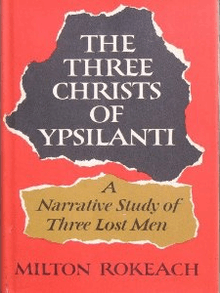The Three Christs of Ypsilanti
 Cover of the first edition | |
| Author | Milton Rokeach |
|---|---|
| Country | United States |
| Language | English |
| Subject | Psychology, schizophrenia |
| Publisher | Knopf |
Publication date | 1964 |
| Pages | 336 |
| ISBN | 0394703952 (1973 edition) |
The Three Christs of Ypsilanti (1964) is a book-length psychiatric case study by Milton Rokeach, concerning his experiment on a group of three patients with paranoid schizophrenia at Ypsilanti State Hospital[1] in Ypsilanti, Michigan. The book details the interactions of the three patients, Clyde Benson, Joseph Cassel, and Leon Gabor, who each believed himself to be Jesus Christ.
Synopsis
Rokeach got the idea from an article in Harper's Magazine describing two women who both believed they were the Virgin Mary. After being assigned as psychiatric hospital roommates, one of the women recovered from her delusion as a result of conversations with the roommate and was discharged.[2] As a similar study of delusional belief systems, Rokeach brought together three men who each claimed to be Jesus Christ and confronted them with one another's conflicting claims, while encouraging them to interact personally as a support group. Rokeach also attempted to manipulate other aspects of their delusions by inventing messages from imaginary characters. He did not, as he had hoped, provoke any lessening of the patients' delusions, but did document a number of changes in their beliefs.
While initially the three patients quarreled over who was holier and reached the point of physical altercation, they eventually each explained away the other two as being patients with a mental disability in a hospital, or dead and being operated by machines.[3] The graduate students who worked with Rokeach on the project have been strongly critical of the morality of the project because of the amount of dishonesty and manipulation by Rokeach and the amount of distress experienced by the patients.[4] Rokeach added a comment in the final revision of the book that, while the experiment did not cure any of the three Christs, "It did cure me of my godlike delusion that I could manipulate them out of their beliefs."[4]
Editions
The Three Christs of Ypsilanti was first published in 1964. Rokeach came to think that his research had been manipulative and unethical, and he offered an apology in the afterword of the 1984 edition of the book: "I really had no right, even in the name of science, to play God and interfere round the clock with their daily lives."[3] The book was re-published by New York Review Books in 2011.[1]
References
- 1 2 Milton Rokeach (19 April 2011). The Three Christs of Ypsilanti. New York Review of Books. ISBN 978-1-59017-398-5. Retrieved 24 June 2012.
- ↑ NPR "The Three Christs of Ypsilanti" http://www.npr.org/2014/05/02/309004267/the-three-christs-of-ypsilanti
- 1 2 "Jesus, Jesus, Jesus". Slate Magazine. May 26, 2010. Retrieved May 28, 2010.
- 1 2 NPR "The Three Christs of Ypsilanti" op. cit.